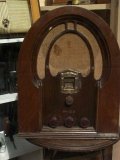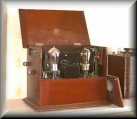Space and acoustics
Acoustics
| Depends on how sound waves spread from their source in an environment (e.g. a room), and are absorbed or reflected or diffracted. |
| Especially for speech. |
| In studio production of radio drama scene dialogue, we must consider the sound-field of each location we seek to represent. |
| We must think of sound's timbre and volume. |
|
Sound is transmitted through air as longitudinal pressure waves. These expand outwards from their source and reduce in level as they spread. Interior locations examples - domestic lounge, public bar, squash court, bedroom, lecture hall, hospital waiting room, telephone box, inside a car, corridor, swimming pool, cathedral, library, etc. The sound wave emits spherical wavefronts. In interior locations the sound-field produced rapidly becomes very complex - both spatially and timbrally. Swimming pool - an interesting example: Domestic livingroom - a less interesting example:
Exterior locations examples - open field in 'The Archers', playing field, high street, on an apartment balcony, outside an airport, town square, top of a mountain, on an open moor, by the sea, by a cliff, in a forest, riding on a horse, etc. In an open playing field - an interesting example:
MORE ON THE 'mise en scène' PRODUCTION CHOICE MORE "Realistic" or stylized? Historical or contemporary? Any sound effects (SFXs) that take on a symbolic function? Or music theme? Any sound effect (SF) accentuated? Why? How do SFXs comment on the narrative?
Choices about the 'mise en scène' (location): Cluttered or empty? Does it express a certain atmosphere? Interior or exterior? What is the geography of the 'mise en scène'? Is this clear? Did you spot an illogicality by any chance? (As a door on the left, and someone exits on the right.) Stylized or natural? The 'mise en scène' within a frame: Open form: frame is de-emphasized, has a documentary "snapshot" quality; Closed form: frame is carefully composed, self-contained, and theatrical; the frame acts as a boundary and a limit. Is space used as an indirect comment on a character's inner state of mind? Fixed sound centre or moving sound centre? |
|
|



